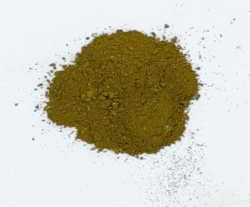 Sample of nickel(II) thiocyanate | |
 Crystal structure of nickel(II) thiocyanate | |
| Identifiers | |
|---|---|
3D model (JSmol) | |
| ChemSpider | |
| ECHA InfoCard | 100.033.808 |
| EC Number |
|
PubChem CID | |
CompTox Dashboard (EPA) | |
| |
| |
| Properties | |
| Ni(SCN)2 | |
| Molar mass | 174.86 g/mol [1] |
| Appearance | green-brown powder |
| Density | 2.59 g/cm3 [1] |
| Melting point | decomposes [1] |
| 5×10−3 cm3/mol [2] | |
| Structure | |
| Hg(SCN)2 structure | |
| Octahedral | |
| Hazards | |
| GHS labelling: | |
   | |
| Danger | |
| H317, H334, H341, H350i, H360D, H372, H410 | |
| P201, P202, P260, P261, P264, P270, P272, P273, P280, P281, P285, P302+P352, P304+P341, P308+P313, P314, P321, P333+P313, P342+P311, P363, P391, P405, P501 | |
| Related compounds | |
Other anions | |
Other cations | |
Except where otherwise noted, data are given for materials in their standard state (at 25 °C [77 °F], 100 kPa). | |
Nickel(II) thiocyanate is a coordination polymer with formula Ni(SCN)2. It is a green-brown solid and its crystal structure was determined first in 1982. [1]